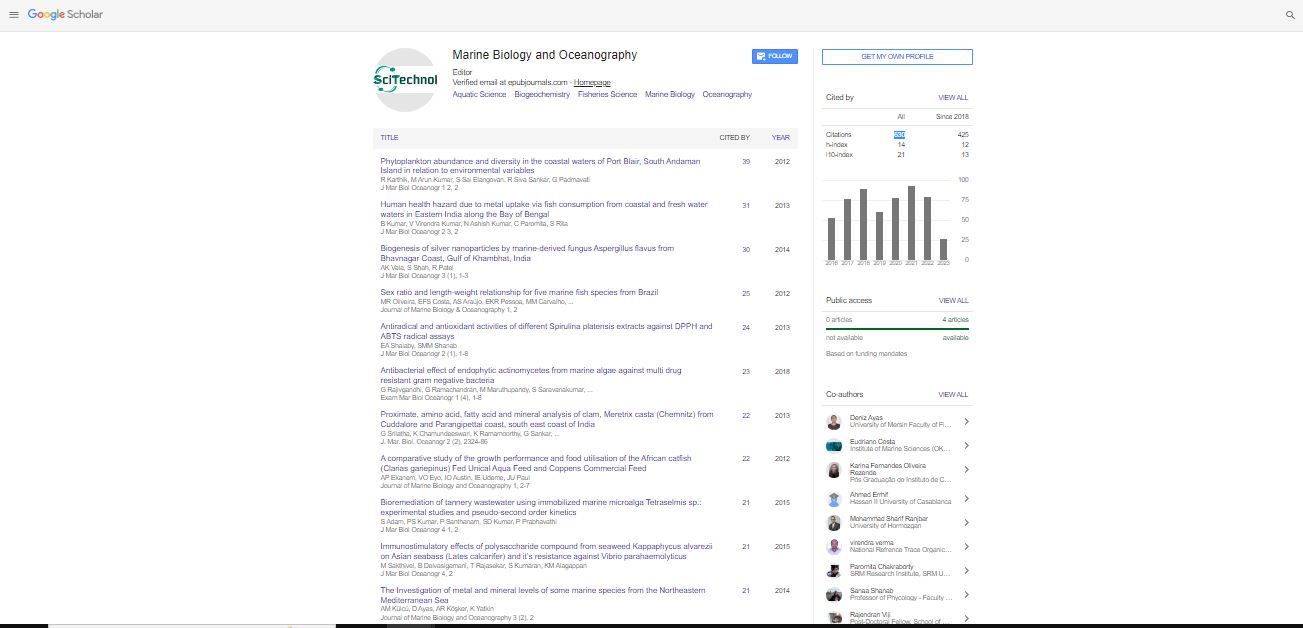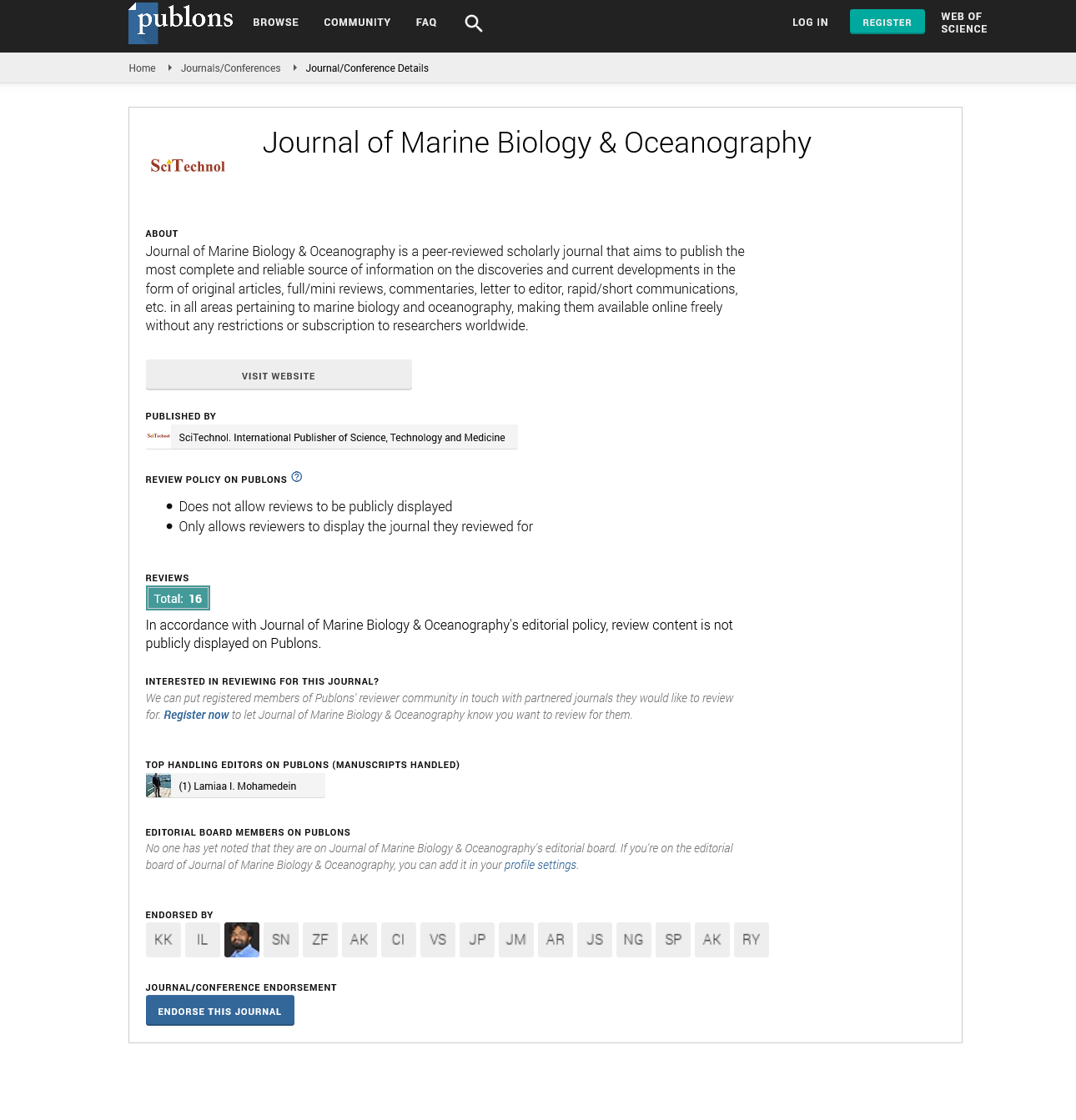Commentary, J Mar Biol Oceanogr Vol: 11 Issue: 5
Control of Trace-Metal Enrichment in Anoxic Marine Facies
Alireza Iranbakhsh*
Department of Biology, Islamic Azad University, Aliabad Katoul, Golestan, Iran
*Corresponding author: Alireza Iranbakhsh
Department of Biology, Islamic Azad University, Aliabad Katoul, Golestan, Iran
Email: alireza65@gmail.com
Received date: 13 April, 2022; Manuscript No. JMBO-22-52523;
Editor assigned date: 15 April, 2022; PreQC No. JMBO-22-52523 (PQ);
Reviewed date: 26 April, 2022; QC No. JMBO-22-52523;
Revised date: 06 May, 2022; Manuscript No. JMBO-22-52523 (R);
Published date: 16 May, 2022; DOI: 10.4172/2324-8661.1000243
Citation: Iranbakhsh A (2022) Control of Trace-Metal Enrichment in Anoxic Marine Facies. J Mar Biol Oceanogr 11:5.
Keywords: Marine Chemistry
Description
The rapid-fire development of Machine Literacy (ML) algorithm will accelerate the disquisition of numerous fields involving toxin analysis. Rather than the model computation capacity the challenge of this process substantially comes from the lack of toxicology big-data to perform toxin perception through the ML model. In this paper, a full strategy grounded a standardized high- outturn trial was developed for Mix-tox analysis throughout the whole routine, from big- sample dataset design, model structure, and training, to the toxin vaticination. Using the attention varieties as input and bio-luminescent inhibition rate as affair, it turned out that a well-trained arbitrary timber algorithm was successfully applied to assess the fusions’ toxin effect, suggesting its value in easing relinquishment of Mix-tox analysis. The standard cure (BMD) is a cure that produces a destined change in the response rate of an adverse effect. This approach is decreasingly employed to dissect quantitative cure- response connections. To evidence this conception, statistical analysis was compared with the BMD approach in order to rank the perceptivity as well as the toxin and to describe the mode of action. Bronchial (BEAS-2B) and alveolar epithelial cells (A549) were exposed to a wide attention range (0.4–100μg/mL) of five essence oxide nanoparticles .Eight toxin endpoints were determined representing integrity of lysosomal and cell membrane, oxidative stress position, glutathione grounded detoxification (glutathione Stransferees), oxidative metabolism (cytochrome P450), revision of the mitochondrial membrane eventuality, revision of phase II ant oxidative enzyme (NAD (P) Hquinone oxidoreductase), and de novo DNA Immune checkpoint asset with radiation remedy (ICI RT) is under disquisition for bettered patient outgrowth, so we performed a methodical review/meta-analysis of venom for ICI RT compared to vulnerable checkpoint asset (ICI) remedy alone. PRISMA-biddable methodical review of studies in MEDLINE (PubMed) and in the National Comprehensive Cancer Network guidelines was conducted, with primary outgrowth grade 3 toxins.
Criteria for ICI alone were phase III/IV trials that compared immunotherapy to placebo, chemotherapy, or indispensable immunotherapy; and for ICI RT prospective/retrospective studies with an arm treated with ICI RT. Meta-analysis was performed by arbitrary goods models using the DerSimonian and Laird system. The I2 statistic and Cochran’s Q test were used to assess diversity, while channel plots and Egger’s test assessed publication bias. In this study, the goods of doping of CQDs with indispensable functional groups (dopants) were estimated through embryonic development of zebra fish (Danio rerio). The CQDs were synthesized using simple and lowcost sources Non-doped (citric acid was used as the carbon source), nitrogen-unravel (N-unravel) and nitrogen, sulfur-co-doped (unravel). The CQDs convinced significant toxin to zebra fish (>150μg/mL) and the poisonous goods were cure-dependent. The-unravel CQDs were the most poisonous (LD50=149.92μg/mL), followed by the N-unravel CQDs (LD50 3=99.95μg/mL) while the non-doped CQDs were the least poisonous (LD50=548.48μg/mL) of the three. The Growth Rate (GR) was affected following the toxin pattern GRNS-unravel.
Oarsman-Atlas
The differences in toxin, growth rate and malfunctions of CQDs were attributed to their doping with different heteroatoms. The-unravel CQDs, unequivocally, displayed the most pronounced goods. Cases with medically inoperable or unrespectable NSCLC treated with conventionally fractionated 3-Dimensional Conformal Radiation Remedy (3DCRT) in prospective clinical trials were eligible for this study. Proximal bronchial tree (PBT) and PBT wall were contoured constantly per RTOG 1106 Oarsman-Atlas. The cure-volume histograms (DVHs) of physical tradition cure (DVHp) and natural effective cure (α/β=2.5; DVH2.5) were generated, independently. The primary endpoint was PBT venom, defined by CTCAE4.0 under the language of bronchial stricture/atelectasis Of 100 cases enrolled, with a standard follow-up of 64 months (95 confidence interval (CI), 50-78), 73 entered 70 Guy or lesser and 17 developed PBT toxin ( grade 1, 8; grade 2, 6; grade 3, 0; and grade 4, 3). The median time interval between RT inauguration and onset of PBT toxin was8.4 months (95 CI, 4.7-44.1). The combined DVHs showed that no case with a PBT outside physical cure<65 Gy developed any PBT toxin. Cox commensurable hazards analysis and receiver operating characteristic analysis demonstrated that V75 of PBT was the most significant diametric parameter for both grade 1 (P=0.035) and grade 2 (P=0.037) PBT venom. The diametric thresholds for V75 of PBT were6.8 and11.9 for grade 1 and grade 2 PBT toxins, independently. Micro plastics which are gradationally and aimlessly putrefy into small scrap by exposure of physical and natural external stress are arising as a significant trouble to the all the surroundings. Then, we've demonstrated the in vitro toxin of micro plastics of two different shapes. To minimize the chemical effect, polyethylene (PE), was used. PE micro plastics with two different shapes were prepared, highviscosity PE micro beads and desultorily ground low-viscosity PE from bulk bullets. It's hypothecated that morphological characteristics and attention of PE micro plastics could affect cellular viability, impunity, and analysis. To quantify the randomness of the micro plastic shape, the edge patterns of the generated PE micro plastics were converted into numerical values and anatomized using a statistical system. A10-fold difference in curve value was observed between micro beads and ground micro fragments. To relate shape differences to toxicology, cells were exposed to PE micro plastics on the demand of toxicology studies. We plant that the advanced attention and rough structure were associated with the toxin of plastics toward cells, pro-inflammatory cytokine release, and hemolysis, indeed though PE is buoyant onto medium. The PE micro beads didn't parade severe cytotoxicity at any of the tested attention, but convinced vulnerable and hemolysis responses at high attention. When comparing the toxin of different shapes of PE micro plastics, we verified by statistical analysis that irregular-shape plastics with sharp edges and advanced curve differences may negatively affect cells, further having possibility to mortal toxin in real terrain. The 90-day toxin study is one of the studies used in the safety assessment of food constituents, drugs or other chemical substances. This paper reviews the current part of the 90-day oral toxin study in European nonsupervisory dossiers of chemicals by reviewing EU legislation and EU and OECD guidance documents. Regulatory vittles with regard to necessity, objects and design of similar 90-day toxin studies vary between the different sectors addressed in this review. Most frequently the 90-day study is anticipated to be part of the standard test battery used for chemical threat assessment, without inescapably being a legal demand and its objects may vary between nonsupervisory disciplines. Exceptions, when a 90-day study isn't needed are spelled out in the chemicals legislation and for food contact accoutrements. The sectorial study design conditions of the 90-day toxin study are veritably frequently bedded in the OECD TG 408 protocol. Differences in study objects aren't inescapably reflected in specific study designs. Considering the call for the reduction of using experimental creatures for scientific purposes and the fact that a 90- day study may serve different purposes, thickness between the necessity to conduct such a study, its objects and the study design to achieve these objects may ameliorate judicious use of laboratory creatures. Therefore there may be an occasion to reflect and further optimize the design of in vivo toxicology studies, similar as the 90-day study. This should be grounded on a methodical analysis of once studies and threat assessments.
 Spanish
Spanish  Chinese
Chinese  Russian
Russian  German
German  French
French  Japanese
Japanese  Portuguese
Portuguese  Hindi
Hindi 
